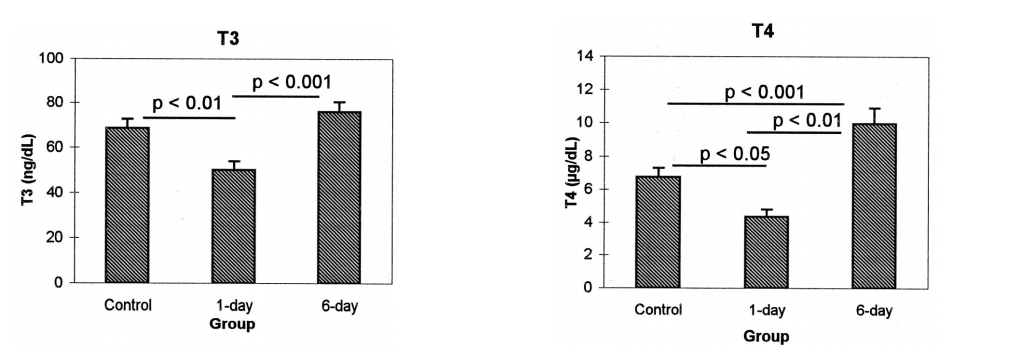
For men who take supplements
—-Important Message—-
A few drops of this restores the sex drive you had as a young horny teenager
Remember being in class and seeing a cute girl bend over and getting an uncontrollable boner that you had to hide?
Or maybe it was the hot teacher in a short skirt…

The point is, you had a super high sex drive and were ready to go practically anywhere, anytime.
And what guy wouldn’t want to have that back!
———-
The Wolff-Chaikoff Effect
The Wolff-Chaikoff Effect is a phenomenon you may have heard about, perhaps as a precaution while reading about iodide supplementation.
The Wolff-Chaikoff Effect is defined as the reduction in thyroxine synthesis observed after unphysiologically high levels of iodide are consumed.
This is somewhat of a paradoxical effect considering that iodide is an indispensable component of thyroid hormone.

This phenomenon would of course be a trivial matter if it weren’t for high levels of iodide (I−) being useful during certain infections, especially fungal and viral ones.
It is considered so useful for this that it’s even sometimes given to infants.
“Of interest, Rafal and Rasmussen in 1991 reported using KI to treat an 84-day-old patient with fixed cutaneous sporotrichosis. They used a dose of 3 drops of SSKI 3 times daily for 3 months with complete response. They claimed that this was the youngest patient reported to have sporotrichosis.” ―Sterling, 2000
The Wolff-Chaikoff Effect is nothing new and had been first reported nearly a century ago, yet even to this day most textbooks fail to mention that it’s reversible even while continuing iodide intake.
The body adapts to high iodide levels by downregulating the sodium/iodide symporter in the thyroid, thus decreasing its uptake accordingly.
The synthesis of thyroid hormone thus resumes normal function under every new baseline value, however high it might be.
“They next demonstrated that this inhibitory effect of excess iodide was transient, lasting from 26–50 hours, and that the thyroid escaped or adapted to prolonged iodide excess, resuming near-normal hormone synthesis.” ―Eng, 1999
Iodide is useful for immunity because it’s a substrate of 3 enzymes: neutrophil myeloperoxidase, lactoperoxidase, and eosinophil peroxidase.
Under the action of these enzymes, iodide (I−) is converted into the antimicrobial molecule hypoiodous acid (HIO).
I− + H2O2 ⟶ HIO + OH−
Although myeloperoxidase use iodide in addition to the chloride ion (Cl−) in an analogous reaction, forming hypochlorite (ClO−), it has been shown that hypoiodous acid (HIO) is much more potent towards fungi and yeast.

Moreover, eosinophil peroxidase and lactoperoxidase cannot use chloride at all. This means that they’re essentially worthless without having either iodide (I−), bromide (Br−), or thiocyanate (SCN−) at their disposal.
And considering the case of myeloperoxidase, the only enzyme that can also use chloride, it’s been determined that it can convert iodide 288,000 times more quickly than chloride.
So compared to the chloride ion, the iodide ion is better because: (1) it’s a substrate of more antimicrobial enzymes, (2) its oxidative product is formed at a much higher rate, and (3) its product is more potent against fungi & yeast.
These facts are undoubtedly the reasons why potassium iodide has been so successful in treating fungal infections of all kinds.
There’s even a study showing that it could prevent respiratory viral infections, another reason to consider taking potassium iodide.
But like all natural things in high amounts, potassium iodide could have minor side effects.
So to help determine whether it should be added to your cabinet, below are some facts about the notorious Wolff-Chaikoff effect.

This is the article everyone cites for the “discovery” of the Wolff-Chaikoff effect, and is what gives it its name, yet the phenomenon was actually discovered 4 years earlier.
This Wolff–Chaikoff study was a continuation of that earlier study on isolated sheep thyroid, but this time in live rats.
They found that what holds true in vitro also holds true in vivo.
Namely, that thyroid hormone synthesis increases in response to iodide up to a point, after which it stops entirely.
This can be seen from the graphs below: Injection 10 γ of iodide increases stored thyroid hormone (dotted line) to a great degree, but injection of 200 γ causes its synthesis to cease entirely for about 14 hours:

The exact concentration of iodide at which thyroxine synthesis effectively “shuts off” is approximately 20–35 γ percent which, in modern units, corresponds to 20 to 35 micrograms per deciliter (20–35 μg⁄dL).
Thyroxine production invariably resumes the moment plasma iodide drops back down to 20–35 γ percent, thus confirming no permanent thyroid damage had occurred.
For these reasons, the authors Woff & Chaikoff had viewed this effect as a safety mechanism to prevent hyperthyroidism in times of iodide excess.
This is reliable, reversible, and causes no permanent sequelae.
“This regulator probably serves to prevent the formation of excessive amounts of hormone by the gland when the body is suddenly flooded with iodine.” ―Wolff & Chaikoff, 1948
So they had confirmed that this effect was transient and thyroxine synthesis resumes after excess iodide is excreted, but what happens when people take high amounts every day?
This is no trivial matter considering how many people were taking iodides for asthma, infection, and Graves’ disease, back then — often in amounts exceeding 1 gram per day.
Well this is exactly what they set-out to study next, publishing their results just 1 year later:

In this study they’d used the same Long-Evans rats as before, but this time injected them with 500 to 2,000 γ iodide, every 8 hours, for up to 4 weeks.
They had again observed the same inhibitory effect on thyroxine synthesis, yet after about 26 to 50 hours it reverted back towards normal, regardless of elevated plasma iodide concentrations in the rats’.
“By the time 50 hours had elapsed, the gland showed a renewed capacity to bind iodine organically—this occurred while the plasma iodine was still high. At later intervals, more and more of the new iodine was organic.” ―Wolff & Chaikoff, 1949
This resumption of normal thyroid hormone synthesis had been termed “the escape” mechanism, and occurs when intrathyroidal I− levels decrease.
The idea that the thyroid has the ability to adapt to excess iodide by inhibiting uptake was proven as early as 1963.
This was convincingly demonstrated after first leaching the thyroids of all iodide, thus proving beyond doubt that transport mechanisms underlie the effect and not iodide saturation.

So it would seem as though the Wolff-Chaikoff effect will only occur in response to each new high level, after which a new steady state is established about 2 days later.
This is in accord with all known data, and the observation that patients on long term iodide therapy have normal thyroid function.
“Since the acute Wolff-Chaikoff effect occurs in man, adaptation may also be presumed to occur since the vast majority of patients given prolonged iodide therapy are able to maintain a euthyroid state.” ―Braverman, 1963
Newer science only supports this mechanism. It is now known that the drop in iodide uptake is a consequence of reduced synthesis of the sodium/iodide symporter in the thyroid:

This study was inspired by the sodium/iodide symporter finally being fully characterized 3 years prior, and its genetic sequence published.
Since it was now possible to use Western blot and PCR to follow changes in the sodium/iodide symporter in response to iodide, this is exactly what these researchers had done.
So they had given rats 0.05% sodium iodide in their drinking water and analyzed the effects that this had.
As expected, they’d found a decrease in both triiodothyronine (T3) and thyroxine (T4) after one day — a textbook example of the Wolff-Chaikoff effect:

Also what was expected, to those familiar with the “escape” mechanism at least, was the finding that hormone levels increased to normal after 6 days — likely even sooner.
This adaptation or “escape” had corresponded to a 40% decrease in sodium/iodide transporter mRNA beginning at 6 hours, then followed by a 75% decrease in its protein levels at around 24 hours.
From this you could suppose that some iodinated molecule was acting as a signal to decrease the expression of the iodide transporter, perhaps even T3 itself.
Such an idea had been proposed over a half-century ago and gains new support from the observations that the sodium/iodide symporter gene contains a thyroid receptor response element, and that T3 has been shown to downregulate it.
“We have amplified this idea and hypothesized that thyroidal I− transport is stimulated by TSH but inhibited by an intrathyroidal substance which contains iodine in organic form and may be an iodothyronine.” ―Halmi, 1962
So this downregulation is what causes the “escape” by blocking excessive iodide uptake, but what is responsible for causing the initial Wolff-Chaikoff effect?
Early theories had centered around thyroid peroxidase and varied depending on what exactly was assumed to be the iodinating species — be it diiodine (I2), hypoiodous acid (HIO), or the iodonium ion (I+).
In each case, too much iodide can be thought to add to and “quench” the precursor of thyroxine synthesis.
The Fawcett & Kirkwood scheme: I2 + I− ⇌ I3−
The Pitt–Rivers scheme: HIO + I− + H+ ⇌ I2 + H2O
The Serif scheme: I+ + I− ⇌ I2
The latter 2 are consistent with kinetic data, yet the Pitt-Rivers scheme seems most realistic.
However, newer data demonstrates that it’s actually an iodinated lipid that is responsible for the Wolff-Chaikoff effect.
It had been discovered that the main iodinated lipid formed after incubating thyroids in 50μM potassium iodide was 2-iodohexadecanal, a product of hypoiodous acid and plasmalogens.
This molecule has been shown to specifically inhibit NADPH oxidase, the “other” enzyme needed for thyroxine synthesis, as well as thyroid adenylate cyclase, both in low micromolar concentrations.
These are highly specific effects, and it’s difficult to imagine anything besides 2-iodohexadecanal underlying the Wolff-Chaikoff effect.
So the Wolff-Chaikoff effect has essentially now been all worked-out and can be seen as a shut-off device, likely mediated by 2-iodohexadecanal, to prevent hypothyroidism during high iodide intakes.
The “escape” follows shortly after the Wolff-Chaikoff effect and can be seen as the establishment of a new baseline.
“The inhibitory action of excess iodide on organic-iodine synthesis in the thyroid gland has been confirmed here but shown to be temporary in nature. The maximum duration of this effect was 50 hours.” ―Wolff & Chaikoff, 1949
The escape necessarily occurs a bit later as it’s mediated transcriptionally by T3, the thyroid receptor, and the sodium/iodide symporter, while the Wolff-Chaikoff effect is mediated enzymatically by 2-iodohexadecanal.
So on account of these considerations, it can be understood how humans taking over 1 gram of potassium iodide per day can have normal thyroid function:

This study had employed 4 “healthy subjects” between the ages of 27 and 36.
For 11 weeks they had taken 30 drops of SSKI per day, a dose corresponding to 1.08 grams of iodide.
Blood was drawn on weekly intervals and assayed for triiodothyronine (T3), thyroxine (T4), and thyroid-stimulating hormone (TSH).
In this small group of subjects, the “escape” hadn’t occurred until the fifth week — perhaps because it took that long for extremely large doses to reach peak plasma levels.

Yet escape occurred nonetheless, and all hormones stayed within their normal ranges. No subject had developed signs of hypothyroidism.
“None of the subjects developed signs or symptoms of hypothyroidism. No thyroid enlargement could be detected on physical examination.” ―Jubiz, 1977
So even at over 1 gram per day iodide, thyroid hormones decreased only slightly and rebounded after 5 weeks.
You could expect even less change from a smaller dose of iodide, and perhaps the Wolff-Chaikoff effect can be avoided entirely by slowly working-up.
—-Important Message—-
This strange method allows BOTH of you to feel orgasmic waves of pleasure for hours

I’ve discovered a new way of doing things between the sheets…
A new way of intercourse that lets you last for hours…
While waves and waves of pleasure crash over you again and again…
You’re in bliss… and so is your partner…
And once you try this, you’ll never want to go back to doing things the old way ever again…
Here’s a short little video I made showing you how
———-

[1] Wolff & Chaikoff. "Plasma inorganic iodide as a homeostatic regulator of thyroid function." Journal of Biological Chemistry (1948) https://www.jbc.org/content/174/2/555.full.pdf
[2] Wolff & Chaikoff. "The temporary nature of the inhibitory action of excess iodide on organic iodine synthesis in the normal thyroid." Endocrinology (1949) https://pdfs.semanticscholar.org/82a5/85601d2336937b46619547757d2fb952612d.pdf
[3] Eng & Braverman. "Escape from the acute Wolff-Chaikoff effect is associated with a decrease in thyroid sodium/iodide symporter messenger ribonucleic acid and protein." Endocrinology (1999) https://pdfs.semanticscholar.org/7e18/13fc368334b4fb2949df29b8758167c263f9.pdf
[4] Braverman & Ingbar. "Changes in thyroidal function during adaptation to large doses of iodide." The Journal of clinical investigation (1963) https://dm5migu4zj3pb.cloudfront.net/manuscripts/104000/104807/JCI63104807.pdf
[5] Jubiz & Carlile. "Serum thyrotropin and thyroid hormone levels in humans receiving chronic potassium iodide." The Journal of clinical endocrinology and metabolism (1977) https://www.ncbi.nlm.nih.gov/pubmed/838843
